10 things to look for when buying a phone
Looking for a new mobile phone? Here are 10 key features you should look out for.

One of the most anticipated phones this year is the W800i from Sony Ericsson | |
Buying a mobile phone these days can be rather confusing, especially since they now come jam-packed with features, from built-in video cameras and MP3 players to onboard PDA and 3D gaming functions. Therefore, to help you make a better buying decision, we have identified 10 key features you should consider when looking for a new phone.
| External
screen/caller ID: On flip phones, this lets you see
who's calling before you open the cover. Many camera phones
can also show a picture of the caller, if one has
previously been attached to a contact. | |
| Phone book and voice
dialling: Consider how many contacts you can store.
Also, voice dialling lets you make calls without using the
keypad, which is particularly handy when you're on a
headset. | |
| Microbrowser: This
lets you surf the wireless Web. If your phone features a
WAP (Wireless Access Protocol) browser, it's optimised to
view sites configured to display on small, mobile devices.
Not all sites, however, are made for WAP browsing. Also,
you can use some Internet-ready phones as a fax modem, but
you'll need to purchase the proper data cables to take
advantage of this feature. | |
| Text messaging, instant
messaging, and e-mail: They allow quick
communication without making a phone call. Be sure to find
out how many messages you are allowed to send and receive
per month. If you're a heavy e-mail user, make sure your
phone supports this feature and consider adding a data plan
to your basic service. | |
| Camera, video recorder,
and picture messaging: Use them for taking pictures,
shooting brief video clips, and sharing them with others.
Most are low-grade VGA models, but some camera
phones have resolutions of more than a megapixel.
2-megapixel models are expected to reach Australia in the
second half of 2005. Some carriers offer better online
tools than others, and multimedia plans vary. Also, a
camera phone is no substitute for a real camera
(yet). | |
| Speakerphone/conference
calling: A speakerphone is useful for multitasking,
such as working on a computer while you're holding a
conversation. Consider getting a unit with a full-duplex
speakerphone, which allows both parties to speak at the
same time. Business travellers who need to set up impromptu
meetings will want to look at a phone that supports
conference calling. | |
| Push to talk: A
walkie-talkie-like service that lets you immediately
connect with individuals or call groups, which is
especially useful for business users who need instant
contact with their colleagues. Best of all, you don't need
a mobile signal to use them. Not all carriers offer this
feature, however. In Australia, Telstra and Optus are the
only operators with push-to-talk
services. | |
| Bluetooth and
infrared: Both features let you wirelessly connect with
external devices. A phone with an infrared port allows
information to be exchange wirelessly with PDAs or PCs. In
addition, you can use Bluetooth to connect to a wireless
headset. | |
| Multimedia options:
Some features to look for include MP3 support, FM radio,
and polyphonic ring tones. 3G handsets also support
streaming video and videoconferencing. However, you'll to
have a 3G service in your area. | |
| Accessories and add-ons: What's available, and what's important to you? Just make sure it's specifically designed for your phone of choice. If no games and applications are on the phone, can you get them? |
Mobile Guides
Phones
Foldable Phones
Headphones
Mobile Accessories
Smartwatches
Wireless Plans
Mobile coupons